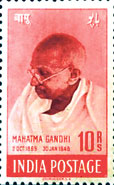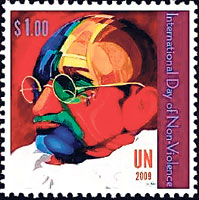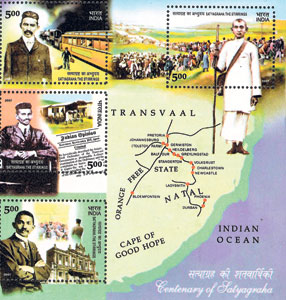Do you recognize the
figure on the UN stamp? You can't make a mistake – it's the great Mahatma Gandhi, the apostle of
non-violence.
The United Nations
honoured him on October 2, 2009 – the International Day of Non-Violence. It is the birthday of Mahatma Gandhi, leader of the Indian independence movement and pioneer of the
philosophy and strategy of non-violence.
The UN has been
celebrating this day
following a resolution adopted by the General Assembly on June 15, 2007. The International Day is an occasion to "disseminate the message of non-violence through education and
public awareness."
The resolution reaffirms “the universal relevance
of the principle of non-
violence" and the desire " to secure a culture of peace, tolerance, understanding and non-violence.”
Announcing the release of the stamp, UN Philatelic Bulletin stated:
"The life and leadership of Mahatma Gandhi have been the
inspiration for non-violent movements for civil rights and social change across the world. Throughout his life, Gandhi remained
committed to his belief in non-violence even under oppressive conditions and in the face of seemingly
insurmountable challenges.
The theory behind Gandhi's actions, which included massive civil disobedience to British law as with the historic Salt March of 1930, was that 'just means lead to just ends'; that is, it is irrational to try to use violence to achieve a peaceful society. He believed that Indians must not use violence or hatred in their fight for freedom from
colonialism.
"The principle of non- violence – also known as non-violent resistance – rejects the use of physical violence in order to achieve social or political change. Often described as 'the politics of the ordinary people', this form of social struggle has been adopted by mass populations all over the world in campaigns for social justice."
A souvenir card has also been released. It carries a quote from Mahatma Gandhi. It says: I have nothing new to teach the world. Truth and
non-violence are as old as the hills.”
The artistic rendition of Mahatma Gandhi
appearing on the stamp was designed by Dr. Ferdie Pacheco (USA) – a medical doctor who developed a
passion for drawing since the age of five.
Meanwhile, Mahatma Gandhi has been honoured in his own native land, India with the release of several stamps over the years. One of the first Gandhi stamps was a soft pink, lovingly saying 'Bapu' in Hindi and Urdu issued just after India gained
independence in 1947. It is generally accepted as the best postage stamp
dedicated to the Father of the Nation.
The search of national identity in the first rush of post-independence stamps
portrayed great leaders, saints, poets, monuments and icons of greatness.
On his birthday two years ago, India released a set of four stamps depicting four different stages of Gandhi's satyagraha
movement in South Africa. 2007 also marked the
centenary of that
satyagraha movement which provided a whole new philosophy of peace and non-violence to the world.
Mohandas Karamchand Gandhi (1869 – 1948) was educated in law at University College, London. In 1891, after having been admitted to the British bar, Gandhi returned to India and attempted to
establish a law practice in Bombay, without much success.
Two years later an Indian firm with
interests in South Africa retained him as legal advisor in its office in
Durban. Arriving in Durban, Gandhi found
himself treated as a
member of an inferior race.
He was appalled at the widespread denial of civil liberties and political rights to Indian immigrants to South Africa. He threw
himself into the struggle for
elementary rights for Indians.
Gandhi remained in South Africa for 20 years, suffering imprisonment many times. In 1896, after being attacked and
humiliated by white South Africans, Gandhi began to teach a policy of passive resistance to, and
non-co operation with, the South African authorities. After returning to India, he led the freedom struggle until the country gained independence from the British Raj. |



